History
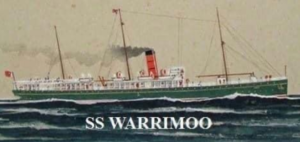 Sometimes, there can be a rare phenomenon that happens by chance, but unlike the phenomenon of twins being born on different days, the phenomenon that took place on December 31, 1899, while not totally planned, had to be helped just a little bit. On that night, the last night of the year, the passenger steamer, SS Warrimoo was quietly making its way through the dark waters of the mid Pacific Ocean on its way from Vancouver, Canada to Australia. In the days without GPS, the navigation was calculated by the stars. It was very accurate. That night, the navigator had just finished working out a star fix and brought the results to Captain John DS Phillips. The Warrimoo’s position was LAT 0º 31′ N and LONG 179 30′ W. The date was December 31, 1899. First mate Payton broke in saying, “Know what this means? We’re only a few miles from the intersection of the Equator and the International Date Line.” At first thought many of us would not see the significance of that, but Captain Phillips saw it, and he was just “prankish” enough to take full advantage of the opportunity for achieving the “navigational freak of a lifetime.”
Sometimes, there can be a rare phenomenon that happens by chance, but unlike the phenomenon of twins being born on different days, the phenomenon that took place on December 31, 1899, while not totally planned, had to be helped just a little bit. On that night, the last night of the year, the passenger steamer, SS Warrimoo was quietly making its way through the dark waters of the mid Pacific Ocean on its way from Vancouver, Canada to Australia. In the days without GPS, the navigation was calculated by the stars. It was very accurate. That night, the navigator had just finished working out a star fix and brought the results to Captain John DS Phillips. The Warrimoo’s position was LAT 0º 31′ N and LONG 179 30′ W. The date was December 31, 1899. First mate Payton broke in saying, “Know what this means? We’re only a few miles from the intersection of the Equator and the International Date Line.” At first thought many of us would not see the significance of that, but Captain Phillips saw it, and he was just “prankish” enough to take full advantage of the opportunity for achieving the “navigational freak of a lifetime.”
Phillips called his navigators to the bridge to check and double check the ship’s position. It simply would not do for there to be any miscalculation. He changed course slightly so as to bear directly on his mark. Then, he adjusted the engine speed for perfect timing. The calm weather and clear night worked in his favor. With determined and careful maneuvering, the SS Warrimoo was in perfect position at midnight. The ship now sat on the Equator at exactly the point where it crossed the International Date Line! This seems like a minor thing, but 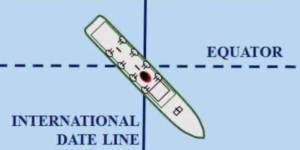 the consequences of this bizarre position were actually many. This put the forward part (bow) of the ship was in the Southern Hemisphere and in the middle of summer; the rear (stern) was in the Northern Hemisphere and in the middle of winter; the date in the aft part of the ship was December 31, 1899; in the bow (forward) part it was January 1, 1900. They had managed to place the ship not only in two different days, two different months, two different years, and two different seasons…but, in two different centuries…all at the same time!! Amazing, and unlikely to ever happen again, unless it was specifically planned.
the consequences of this bizarre position were actually many. This put the forward part (bow) of the ship was in the Southern Hemisphere and in the middle of summer; the rear (stern) was in the Northern Hemisphere and in the middle of winter; the date in the aft part of the ship was December 31, 1899; in the bow (forward) part it was January 1, 1900. They had managed to place the ship not only in two different days, two different months, two different years, and two different seasons…but, in two different centuries…all at the same time!! Amazing, and unlikely to ever happen again, unless it was specifically planned.

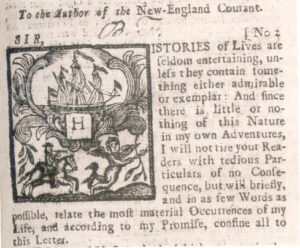 Out of the blue, in 1722, the readers of a paper published in Boston, called The Courant, were treated to and fascinated by letters that were sent in by a widow with an razor-sharp wit and a gift for sarcasm. Her name was Mrs Silence Dogood. Mrs Dogood had an unusual sense of humor. She liked to poke fun at such illustrious institutions such as Harvard. For that, many of her readers loved her and became avid followers. She wasn’t afraid to speak her mind, and she wasn’t afraid to call a spade a spade. She told it like it was, and she didn’t care what others thought of her.
Out of the blue, in 1722, the readers of a paper published in Boston, called The Courant, were treated to and fascinated by letters that were sent in by a widow with an razor-sharp wit and a gift for sarcasm. Her name was Mrs Silence Dogood. Mrs Dogood had an unusual sense of humor. She liked to poke fun at such illustrious institutions such as Harvard. For that, many of her readers loved her and became avid followers. She wasn’t afraid to speak her mind, and she wasn’t afraid to call a spade a spade. She told it like it was, and she didn’t care what others thought of her.
So…just who was Mrs Dogood? Rumor had it that she was just an old widow woman who had been around long enough to have long lost any concern over what people thought of her. Maybe her many years of life had given her insight that no one else had. I remember reading Ann Lander’s column when I was a girl and a young married woman. Her advise always seemed so wise. I remember a number of articles from various columnists, and there again, my thought was, “How did they know so much?” I was sure they must have multiple degrees. Of course, while they might have had a degree or two, that did not make them any smarter than the next guy…and this type of writing was usually more about logic and common sense, that learned skill. So, who was Mrs Silence Dogood? That is the question of the day.
The answer to that question will most likely shock you. The reality is that Mrs Silence Dogood was the pen name used by Benjamin Franklin. Now, while Benjamin Franklin was a very intelligent man, as we all know. the fact remains that at the time he was writing under the pen name of Mrs Silence Dogood, Franklin was a boy of just 16 years. He was too young to be taken seriously or to have any possibility of getting his writings published, so he came up with an ingenious solution. His goal was to have his work published in the New-England Courant…a newspaper founded and published by his brother James Franklin. He took this goal seriously, especially after he was denied several times when he tried to publish letters under his own name in the Courant. Mrs Silence Dogood wrote 14 letters, which were first printed in 1722, and can be read here.
At the time of the printing of those letters, Franklin worked as an apprentice in his older brother’s printing shop in Boston. Franklin was a boy who had yet to get something he wrote published, so at 16, and desperate to finally receive the respect and recognition he felt he justly deserved. His idea was to create the persona of a 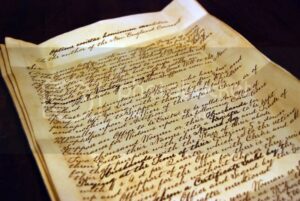
 middle-aged widow named Silence Dogood. Once every two weeks, Franklin left a letter under the door of his brother’s printing shop. A total of 14 letters were sent. For months no one knew the identity of Mrs Dogood, but everyone was completely enthralled. Those letters were the talk of the town…even after they found out they were written by a 16-year-old Benjamin Franklin.
middle-aged widow named Silence Dogood. Once every two weeks, Franklin left a letter under the door of his brother’s printing shop. A total of 14 letters were sent. For months no one knew the identity of Mrs Dogood, but everyone was completely enthralled. Those letters were the talk of the town…even after they found out they were written by a 16-year-old Benjamin Franklin.
 Abraham Lincoln was a great president, one of the greatest, but while the presidency defined his life in our minds, it was only a small part of the sum total of his life. His presidency ran from 1861 to his assassination on April 14, 1865, and subsequent death on April 15, 1865. Nevertheless, Abraham Lincoln was an amazing president and brought this country out of a dark time in our history.
Abraham Lincoln was a great president, one of the greatest, but while the presidency defined his life in our minds, it was only a small part of the sum total of his life. His presidency ran from 1861 to his assassination on April 14, 1865, and subsequent death on April 15, 1865. Nevertheless, Abraham Lincoln was an amazing president and brought this country out of a dark time in our history.
Lincoln was a self-educated man, and he tried a number of occupations. One of them was bartending. It’s strange to think of President Lincoln as a licensed bartender. It’s not that there is anything wrong with bartending, and in fact, many American historical figures were involved in the alcohol industry. George Washington owned the largest whiskey distillery according to Mount Vernon’s official website, and according to Monticello’s website, Thomas Jefferson was also fascinated with beer brewing. Even Sam Adams, who was not a brewer, was involved in the industry, in that he made malt for the breweries. For his part, Lincoln, who would become the 16th president, opened up a bar called “Berry and Lincoln” with his friend William F Berry in New Salem, Illinois in 1833.
When Lincoln came home from serving in the Black Hawk War, which was the war between the United States and Native Americans, he didn’t really know what he wanted to do with the rest of his life. He thought about becoming a blacksmith, but then he reconnected with William Berry, who had been in his militia group. The two men hit it off, and eventually decided to open a general store in New Salem, Illinois. The store was called the Berry-Lincoln Grocery, and maybe it would have been better if this was as far as things went. At that time, stores were allowed to sell larger quantities of alcohol for drinking off-site. However, if they wanted their customers to be able to drink inside the sore, they would need to purchase a license. They were granted a tavern license which cost $7 in those days. Berry took charge of getting the license. They sold a variety of brandy flavors, including apple brandy, peach brandy, and even French brandy, among others. They also sold wine, rum, and two kinds of gin.
Lincoln wasn’t much interested in tending bar. He was more focused on serving as postmaster. So, it was decided that Barry would run the bar part of the store and Lincoln would run the store’s post office. For a time, the Berry-Lincoln Grocery did fine, but then things began to change. It turned out Berry was an alcoholic who took advantage of the store’s license to sell drinks. It gave him the ability to drink while working, and  sometimes he was too drunk to function. So, Lincoln took more and more responsibility. Unfortunately, the whole situation led to the partners, taking on more debt. Eventually, Lincoln was done with the whole thing, and he sold his interest in the store to Berry in 1833. Just two years later, before Lincoln could be completely freed of the place, Berry died, leaving Lincoln to inherit the business’s debts. It was an awful situation, which was only resolved when Lincoln was elected to Congress in 1847, giving him enough of an income to clear the debts. Having had quite enough of the bartending/store owning industry, Lincoln became a lawyer and eventually a politician, which led to the great president we have all studied about, as well, of course, as his assassination.
sometimes he was too drunk to function. So, Lincoln took more and more responsibility. Unfortunately, the whole situation led to the partners, taking on more debt. Eventually, Lincoln was done with the whole thing, and he sold his interest in the store to Berry in 1833. Just two years later, before Lincoln could be completely freed of the place, Berry died, leaving Lincoln to inherit the business’s debts. It was an awful situation, which was only resolved when Lincoln was elected to Congress in 1847, giving him enough of an income to clear the debts. Having had quite enough of the bartending/store owning industry, Lincoln became a lawyer and eventually a politician, which led to the great president we have all studied about, as well, of course, as his assassination.

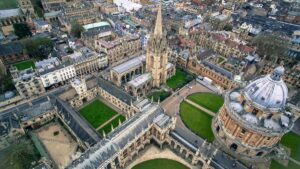 Because I live in the United States, the history of my country doesn’t really go back beyond 1492, and even then, the buildings, institutions, cities, and such would seem pretty primitive compared to their “Old World” counterparts. As old as some of our buildings are, they are new compared to some of the “Old World” structures. The American education system had primitive beginnings to, and so it’s hard to think of the beginning of universities here, and yet, the oldest university in the continental United States is Harvard, which was established in 1636. That seem very old to me, but when compared to the oldest universities in the world, that is a baby university.
Because I live in the United States, the history of my country doesn’t really go back beyond 1492, and even then, the buildings, institutions, cities, and such would seem pretty primitive compared to their “Old World” counterparts. As old as some of our buildings are, they are new compared to some of the “Old World” structures. The American education system had primitive beginnings to, and so it’s hard to think of the beginning of universities here, and yet, the oldest university in the continental United States is Harvard, which was established in 1636. That seem very old to me, but when compared to the oldest universities in the world, that is a baby university.
The universities in the United States, were modeled after some of the universities in Europe, like the University of Oxford. The University of Oxford is older than the Aztec Empire, which is said to have originated in 1325. The University of Oxford first opened its doors to students all the way back in 1096, making it the oldest university  in the English-speaking world and the world’s second-oldest university in continuous operation. That seems an impossible date, but while 1096 is a very, very long time ago, the University of Oxford is not even the oldest university in the world. In fact, it is actually the fourth oldest university in the world. Still, it is quite prestigious. “Oxford has educated a wide range of notable alumni, including 30 prime ministers of the United Kingdom and many heads of state and government around the world. As of October 2022, 73 Nobel Prize laureates, 4 Fields Medalists, and 6 Turing Award winners have matriculated, worked, or held visiting fellowships at the University of Oxford, while its alumni have won 160 Olympic medals. Oxford is the home of numerous scholarships, including the Rhodes Scholarship, one of the oldest international graduate scholarship programs.” All that is to be expected for a university with such long standing.
in the English-speaking world and the world’s second-oldest university in continuous operation. That seems an impossible date, but while 1096 is a very, very long time ago, the University of Oxford is not even the oldest university in the world. In fact, it is actually the fourth oldest university in the world. Still, it is quite prestigious. “Oxford has educated a wide range of notable alumni, including 30 prime ministers of the United Kingdom and many heads of state and government around the world. As of October 2022, 73 Nobel Prize laureates, 4 Fields Medalists, and 6 Turing Award winners have matriculated, worked, or held visiting fellowships at the University of Oxford, while its alumni have won 160 Olympic medals. Oxford is the home of numerous scholarships, including the Rhodes Scholarship, one of the oldest international graduate scholarship programs.” All that is to be expected for a university with such long standing.
The other three oldest universities are the University of Bologna, a public research university in Bologna, Italy, founded in 1088 at number three; the Al-Azhar University, a public university in Cairo, Egypt, founded in 970 at number two; and the oldest university in the world, the University of al-Qarawiyyin, located in Fes, Morocco, founded in 859. It amazes me that there could be universities that have been around for that many years. I 
 think that mostly, it’s not the institutions of higher learning that amaze me, but more the structures that held them and the institutions of people who ran them. I think that there has always been a desire to learn more, so the universities themselves make perfect sense, but the buildings built so long ago that have somehow managed to remain standing, while so many other structures are in total disrepair, is astounding.
think that mostly, it’s not the institutions of higher learning that amaze me, but more the structures that held them and the institutions of people who ran them. I think that there has always been a desire to learn more, so the universities themselves make perfect sense, but the buildings built so long ago that have somehow managed to remain standing, while so many other structures are in total disrepair, is astounding.
 When I first heard about the bizarre phenomenon found under the home of Benjamin Franklin, I thought of a few possibilities. The remains, found in 1998, consisted of 1,200 bones are believed to be from more than 15 human bodies found in the basement of Ben Franklin’s house. Six of the bodies were children. My first thought was, “Please tell me that this is some Indian burial site, or that there is some logical explanation as to why there would be bodies buried in this hero Founding Father’s home.” I have always liked Ben Franklin. I found his “antics” to be so interesting. To say the least, he was a bit strange in his experimentations, and that was enough to make me wonder (and hope it wasn’t so) if Ben Franklin could possibly have some horrid alter ego. He wouldn’t be the first scientist to go off the deep end to experiment on human bodies, but then again, there certainly are people today that have chosen to donate their bodies to science, so why couldn’t that be the case back then. I prayed that was the case.
When I first heard about the bizarre phenomenon found under the home of Benjamin Franklin, I thought of a few possibilities. The remains, found in 1998, consisted of 1,200 bones are believed to be from more than 15 human bodies found in the basement of Ben Franklin’s house. Six of the bodies were children. My first thought was, “Please tell me that this is some Indian burial site, or that there is some logical explanation as to why there would be bodies buried in this hero Founding Father’s home.” I have always liked Ben Franklin. I found his “antics” to be so interesting. To say the least, he was a bit strange in his experimentations, and that was enough to make me wonder (and hope it wasn’t so) if Ben Franklin could possibly have some horrid alter ego. He wouldn’t be the first scientist to go off the deep end to experiment on human bodies, but then again, there certainly are people today that have chosen to donate their bodies to science, so why couldn’t that be the case back then. I prayed that was the case.
At this point, many people would immediately assume that Ben Franklin was some kind of closet killer, who tortured and murdered his victims. It would be thought that the world had been so naive, that we lived in the dark for years, but before you go crafting a murder mystery about him, please be aware that it was revealed that the bodies were used in the study of human anatomy. So, it actually was bodies donated for scientific 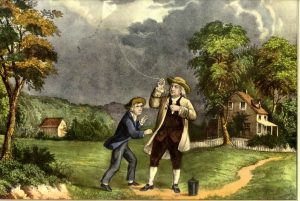 research. I certainly didn’t know that they did that sort of thing back then, but it seems that they did.
research. I certainly didn’t know that they did that sort of thing back then, but it seems that they did.
The house, located in London, England was undergoing some conservation work in 1998, when the bones were discovered. Some of the bodies were dismembered, or had trepanned skulls, which is skulls with holes drilled through them. Ben Franklin had lived home in London for nearly twenty years leading up to the signing of the Declaration of Independence. It was more than 200 years later, when the conservation work uncovered the 15 bodies in the basement, buried in a secret, windowless room beneath the garden. While on could imagine horrible things, “The most plausible explanation is not mass murder, but an anatomy school run by Benjamin Franklin’s young friend and protege, William Hewson.” So, it would seem that Ben Franklin either loaned the home to Hewson (a surgeon), stored the bodies for Hewson, or allowed Hewson to do his scientific experiments in the room in the Franklin house. Whatever the case may be, it is apparently well enough documented that the authorities were satisfied that Ben Franklin wasn’t personally involved.
One such speculation was that “Anatomy was still in its infancy, but the day’s social and ethical mores frowned upon it. … A steady supply of human bodies was hard to come by legally, so Hewson, Hunter, and the field’s other pioneers had to turn to grave robbing—either paying professional ‘resurrection men’ to procure cadavers  or digging them up themselves—to get their hands on specimens. Researchers think that 36 Craven was an irresistible spot for Hewson to establish his own anatomy lab. The tenant was a trusted friend, the landlady was his mother-in-law, and he was flanked by convenient sources for corpses. Bodies could be smuggled from graveyards and delivered to the wharf at one end of the street or snatched from the gallows at the other end. When he was done with them, Hewson simply buried whatever was left of the bodies in the basement, rather than sneak them out for disposal elsewhere and risk getting caught and prosecuted for dissection and grave robbing.” Some people speculate that Ben Franklin knew about the goings on, but was not personally involved, still, they thought he might have gone to the lab a few times to check out the proceedings. I hate to think that he knew anything about it, and I would prefer to think that the study of anatomy was done in his absence, but I suppose that our modern-day anatomy studies and autopsies were probably pioneered in a basement somewhere.
or digging them up themselves—to get their hands on specimens. Researchers think that 36 Craven was an irresistible spot for Hewson to establish his own anatomy lab. The tenant was a trusted friend, the landlady was his mother-in-law, and he was flanked by convenient sources for corpses. Bodies could be smuggled from graveyards and delivered to the wharf at one end of the street or snatched from the gallows at the other end. When he was done with them, Hewson simply buried whatever was left of the bodies in the basement, rather than sneak them out for disposal elsewhere and risk getting caught and prosecuted for dissection and grave robbing.” Some people speculate that Ben Franklin knew about the goings on, but was not personally involved, still, they thought he might have gone to the lab a few times to check out the proceedings. I hate to think that he knew anything about it, and I would prefer to think that the study of anatomy was done in his absence, but I suppose that our modern-day anatomy studies and autopsies were probably pioneered in a basement somewhere.
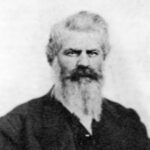 Politics can be a touchy subject. Many arguments have come from political disagreements, and in fact, a number of actual fights and even wars have been fought over political disagreements. The Civil War was one sch war fought over political views. During that time there were also a number of private disputes as well. Sumner Pinkham was in volved on one of those disputes. Sumner Pinkham was born in 1820 in the state of Maine and was raised in Wisconsin. Very little, if anything, is known about his early life. He married Laurinda Maria Atwood in Nebraska on November 4, 1842. In 1849, Pinkham joined the California gold rush and then spent time in Oregon before making his way to the booming gold rush camp of Idaho City in 1862. Pinkham was a big man…powerfully built, who stood six feet two inches tall and had a barrel chest. He was also prematurely gray, making him look older than he really was.
Politics can be a touchy subject. Many arguments have come from political disagreements, and in fact, a number of actual fights and even wars have been fought over political disagreements. The Civil War was one sch war fought over political views. During that time there were also a number of private disputes as well. Sumner Pinkham was in volved on one of those disputes. Sumner Pinkham was born in 1820 in the state of Maine and was raised in Wisconsin. Very little, if anything, is known about his early life. He married Laurinda Maria Atwood in Nebraska on November 4, 1842. In 1849, Pinkham joined the California gold rush and then spent time in Oregon before making his way to the booming gold rush camp of Idaho City in 1862. Pinkham was a big man…powerfully built, who stood six feet two inches tall and had a barrel chest. He was also prematurely gray, making him look older than he really was.
Pinkham was a conservative Republican, a Unionist, and an abolitionist, which put him on the opposite side of the majority of Boise Basin mining camps political views, which were predominantly Democrat. When Pinkham arrived in the Idaho City area, Idaho was still a part of Washington Territory, and the Boise Basin was located in Idaho County, of which Florence was the county seat. Florence was located a way away from the new mining basin, so the Washington Legislature established Boise County on January 29, 1863.
After being in the area for a while, and becoming known for his political views, the Governor of Washington was assigning commissioners and officers to the newly established county, and Pinkham was one of them, assigned to serve as the County Sheriff. On March 4, 1863, Congress created Idaho Territory. At that time Boise County exceeded the other counties in both area and in population. Those in office in Boise County at the time, including Pinkham, retained their positions until the territorial government could be officially organized. Pinkham appointed Orlando “Rube” Robbins, who shared his political opinions, as his deputy in August 1863. Robbins would later make himself known as one of Idaho’s greatest lawmen.
By this time, the Civil War was raging back East, and the area miners began to choose sides, around the Union and Confederate causes. This, dueled with whiskey, caused flair-ups between North and South sympathizers, bring with it fist fights, knife fights, and sometimes gun battles as they used force to show their opinions. That kept both Pinkham and his deputy, Rube Robbins, busy breaking up fights and locking up drunken loudmouths as they threatened to fight it out…to the death. The area being predominately Democrat often placed Pinkham at odds with his constituents due to his staunch Unionist views, Republican politics, and tough law enforcement. His list of enemies grew. Nevertheless, both Pinkham’s enemies and his most loyal friends knew that he was a man they shouldn’t mess with when he undertook to enforce the law, which he did with an iron hand.
His greatest enemy was a Southern gunfighter named Ferdinand “Ferd” Patterson. On one occasion, while Patterson was partying with some of his friends in Idaho City, they took unlawful possession of a brewery in Idaho City. Sheriff Pinkham was called by the owner to remove the rowdy group. When Pinkham entered the brewery, he was met with violent resistance. Pinkham and Patterson immediately hated each other. Patterson was Southerner who was crooked by nature, and Pinkham was a Northerner who tended to be self-righteous. In the end, Pinkham was successful, and Patterson was arrested. When Pinkham lost his October 1864 for re-election as Boise County Sheriff, in a bitter contest between the Democratic successionists and Republican candidates. Pinkham was defeated by A O Bowen by a comfortable majority, and Patterson celebrated, as the last of the ballots were being counted. When Patterson encountered his old nemesis, he began rubbing it in. Pinkham, who was in a rage, swung at Patterson, hitting him in the jaw and throwing the gambler off the street and into the gutter. After that, Pinkham walked away. Everyone expected Patterson to retaliate, but he let it go…for then. Pinkham left Idaho City, following the lost election, heading to Illinois to visit his dying mother. When he returned in 1865, everyone figured they would have it out, but it didn’t happen then either.
After the Civil War ended, Pinkham held a huge Fourth of July party. The crowds were mostly festive, with fireworks blazing and booze abundant. The celebration included a brass band, speeches, patriotic songs, a picnic, and a parade with Pinkham leading the way through town. For the victorious Yankees, it was a proud day. But, for the sullen Confederate sympathizers…not so much. To make matters worse, the Yankee’s heckled the “Blue Bellies” throughout the day. Patterson was furious as he watched Pinkham leading the parade through town. Pinkham singing, “Oh, we’ll hang Jeff Davis to a sour apple tree!” was the last straw. Patterson yelled out to the ex-sheriff that if “he didn’t shut his mouth, he’d shut it for him.” Pinkham invited him to try, and he did. A brief fist fight between the two men resulted in the flag falling into the dust of the street. Some witnesses swore they saw Patterson spit on it, and others attested they heard Pinkham swear he would kill Patterson for that, but nothing more came of it at that time. Several weeks later, on Sunday, July 23rd, Pinkham took a hired carriage from Idaho City to the Warm Springs Resort, which was about two miles west of town. Upon his arrival, Pinkham joined a number of his Unionist friends in the saloon, where they were heard singing patriotic and anti-Confederate songs.
Sometime later, Patterson entered the resort while Pinkham was paying his bill. Initially, Patterson ignored Pinkham, but by the time the ex-sheriff exited the resort, Patterson was outside waiting for him. Patterson said the word “draw” and then taunted Pinkham by calling him an “Abolitionist son-of-a-b***h.” Who drew first is in dispute, but in the end, Pinkham was dead. Patterson quickly fled but was immediately followed by several lawmen. Rube Robbins was the first to catch up to him, about 14 miles from Idaho City. Patterson surrendered to Robbins, who turned the killer over to Sheriff Bowen, who was next on the scene. Bowen and his men took over and escorted Patterson back to Idaho City.
A mob wanted to lynch him, and maybe that would have been justice, because in the “sham” trial held in a predominately Democrat area, Patterson was acquitted, and with that, justice for Pinkham would never be served. Ferd Patterson was tried for Pinkman’s murder at the beginning of November 1865. In the six-day trial, defense attorney Frank Ganahl claimed his client acted in self-defense, arguing that Pinkham was lying in wait 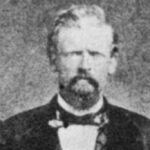 for him. Alternatively, Pinkham’s friends testified that he tried to avoid a showdown and that Patterson came to Warm Springs with the explicit purpose of murdering Pinkham. It took only an hour and a half for the jury to acquit Patterson. Pinkham’s funeral was the largest and most impressive funeral ever seen in the mining camp. It was reported that over 1,500 mourners followed his hearse to the graveyard. Meanwhile, knowing he was in extreme danger, Patterson quickly fled Idaho City after his acquittal. He was killed in Walla Walla, Washington, the next year, by Thomas Donahue, an area policeman, in was thought by many to be an assassination. Donahue was charged with the murder of Patterson, but escaped from jail while awaiting trial. There apparently was little interest in tracking him down. He disappeared never to be heard from again.
for him. Alternatively, Pinkham’s friends testified that he tried to avoid a showdown and that Patterson came to Warm Springs with the explicit purpose of murdering Pinkham. It took only an hour and a half for the jury to acquit Patterson. Pinkham’s funeral was the largest and most impressive funeral ever seen in the mining camp. It was reported that over 1,500 mourners followed his hearse to the graveyard. Meanwhile, knowing he was in extreme danger, Patterson quickly fled Idaho City after his acquittal. He was killed in Walla Walla, Washington, the next year, by Thomas Donahue, an area policeman, in was thought by many to be an assassination. Donahue was charged with the murder of Patterson, but escaped from jail while awaiting trial. There apparently was little interest in tracking him down. He disappeared never to be heard from again.
 Miracles happen every day, whether we realize it or not. Each and every day, people’s lives are changed, people are healed, and circumstances are corrected, in ways that have no logical, scientific, medical, or financial reason. One such case occurred in 2007. A man went to the hospital because he was experiencing minor weakness in his left leg. Of course, as hospitals do, they ran a battery of tests. When they did a CT scan and an MRI, they were shocked to find that the man had an unusually tiny brain. When I say unusually tiny, I don’t mean a little smaller than normal, I mean a lot smaller than normal. Even more amazing was the fact that the man was more or less normal and functional.
Miracles happen every day, whether we realize it or not. Each and every day, people’s lives are changed, people are healed, and circumstances are corrected, in ways that have no logical, scientific, medical, or financial reason. One such case occurred in 2007. A man went to the hospital because he was experiencing minor weakness in his left leg. Of course, as hospitals do, they ran a battery of tests. When they did a CT scan and an MRI, they were shocked to find that the man had an unusually tiny brain. When I say unusually tiny, I don’t mean a little smaller than normal, I mean a lot smaller than normal. Even more amazing was the fact that the man was more or less normal and functional.
Lionel Feuillet, the neurologist handling the case, at the Mediterranean University in Marseille, France, told New Scientist that “visually, it is more than a 50% to 75% reduction.” Of course, a picture is worth a thousand words, but even the pictures are beyond belief. I don’t know how he was even alive, much less functional. The mystery immediately demanded the full attention of all the doctors and quite likely doctors worldwide. In researching the case, they found that the man had a childhood condition called hydrocephalus, commonly called water on the brain. Left untreated, the condition can be deadly. The treatment is fairly simple. A stent is placed to drain the water. This was the treatment the man had received as a boy.
Then, when he was 14 years old, the stent was removed. No specific reason for the removal was stated, but apparently, they decided that he didn’t need the stent any longer. From the situation at the time, he went into the hospital, it’s a logical assumption that his childhood condition continued to affect the man’s brain after the stent was removed, slowly filling over time. Slow enough that the brain was able to remap itself in an amazing  display of the brain’s adaptability, which enabled him to live a normal life. His IQ was reported to be 75, which is below the average of 100, but not low enough to be deemed mentally retarded or disabled. I suppose some would call that “the amazing brain” and nothing more, but the brain was created by God, and so could be fixed by God. In fact, I believe that this man’s brain could continue to improve over time. Still, he has led a good life. He is even married and has two children. For a man who is missing up to 75% of his brain, that is amazing.
display of the brain’s adaptability, which enabled him to live a normal life. His IQ was reported to be 75, which is below the average of 100, but not low enough to be deemed mentally retarded or disabled. I suppose some would call that “the amazing brain” and nothing more, but the brain was created by God, and so could be fixed by God. In fact, I believe that this man’s brain could continue to improve over time. Still, he has led a good life. He is even married and has two children. For a man who is missing up to 75% of his brain, that is amazing.
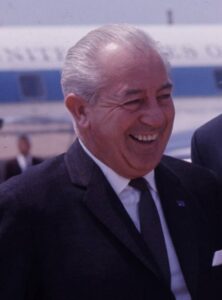
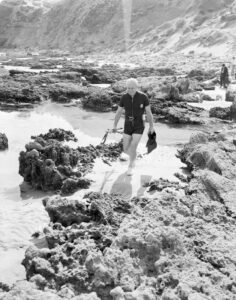 When someone goes missing, it leaves a number of people at a standstill, so to speak. At first, they think they can find the person quickly, but then, if the ordeal carries on for a while, they begin to lose hope of ever seeing their loved one again. When the missing person is someone of prominence, the case goes very public, very quickly, and while that could help find the person, it also puts a negative connotation on the situation.
When someone goes missing, it leaves a number of people at a standstill, so to speak. At first, they think they can find the person quickly, but then, if the ordeal carries on for a while, they begin to lose hope of ever seeing their loved one again. When the missing person is someone of prominence, the case goes very public, very quickly, and while that could help find the person, it also puts a negative connotation on the situation.
On December 17, 1967, in what turned out to be an unsolved missing person case, Harold Edward Holt, who was Australia’s 17th Prime Minister and a member of parliament for 32 years, disappeared during his first term in office as Prime Minister. He was never found, and the case remains unsolved to this day. That December 17th was a Sunday morning. Holt decided to drive down to Melbourne with friends and bodyguards to see British Yachtsman Alec Rose sail through port. The plan was to watch the yacht go through, and then head down to Holt’s favorite swimming and snorkeling spot at Cheviot Beach, east of Port Phillip Bay. While there, Holt decided to take a swim. Holt went down to the water, which has notoriously strong currents and rip tides. Soon after going in, Holt disappeared from view and the situation quickly escalated into one of Australia’s largest search operations ever, but the search was in vain, and Holt was never found.
Now, this might seem like a simple case of drowning, but with no body found, there is always room for speculation as to the “real” reason for his disappearance. People began to speculate that he was caught in strong currents and then dragged underwater and whisked further out to sea. That would be the most logical cause of his disappearance, but it was also speculated that he may have faked his own death to run off with his mistress. It seems strange that he would walk away from his sons too, but you never know.
Holt was born on August 5, 1908, at his parents’ home in Stanmore, New South Wales, a suburb of Sydney. He was the first of two sons born to Olive May (née Williams; formerly Pearce) and Thomas James Holt. In 1927, Holt began studying law at the University of Melbourne, while living at Queen’s College on a scholarship. He represented the university in cricket and football, and was also active in various student organizations, serving as president of the Law Students’ Society and of the Queen’s College Social Club. Holt won prizes for oratory and essay-writing and was a member of the inter-university debating team. He graduated with a Bachelor of Laws degree in 1930. Holt’s father, who was living in London, invited him to continue his studies in England, but he declined the offer. Holt served his articles of clerkship with the firm of Fink, Best, and Miller. He was admitted to the Victorian Bar in late 1932 and opened his own legal practice the following year. Unfortunately, the Depression brought with it few clients, and he was frequently underpaid. During those years, he lived in a boardinghouse and often relied upon the hospitality of friends. It was this time in his life that made him consider politics. Holt married Zara Dickins, the daughter of a Melbourne businessman, after an on 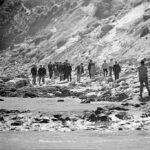
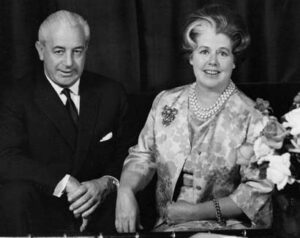 again off again, relationship, and her first marriage to James Fell, a British Indian Army officer. He later adopted her three children, and many people thought he was probably the biological father of her twins, Sam and Adrew, who look a lot like Holt. She also had an older son named Nicholas, whom Holt adopted as well. After his presumed drowning, Zara Holt said that he had been involved in a number of extramarital affairs, sparking the idea that maybe he wasn’t really dead. I doubt we will ever know. A memorial service was held on December 22nd, at St Paul’s Cathedral, Melbourne.
again off again, relationship, and her first marriage to James Fell, a British Indian Army officer. He later adopted her three children, and many people thought he was probably the biological father of her twins, Sam and Adrew, who look a lot like Holt. She also had an older son named Nicholas, whom Holt adopted as well. After his presumed drowning, Zara Holt said that he had been involved in a number of extramarital affairs, sparking the idea that maybe he wasn’t really dead. I doubt we will ever know. A memorial service was held on December 22nd, at St Paul’s Cathedral, Melbourne.
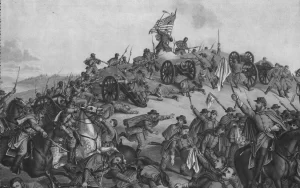 These days, it’s strange to think of battles being fought on US soil. We have begun to believe that a war, at least can’t take place on our soil anymore, because we have so many early warning systems to tell of any incoming missiles or planes, but that wasn’t always the case. The Civil War was one of the biggest wars fought on US soil, and strangely, we were fighting ourselves. Civil Wars are among the worst kinds, because there is so much anger and unrest. We have had a number of wars fought here, including the Civil War, which was clearly one of the worst on our soil. Wars are unpredictable, and the length of battles vary, with some long and drawn out, and some were just one or two days. The Battle of Nashville, Tennessee, fell into the latter category, fought on December 15 and 16, 1864, between the Confederate Army of Tennessee under Lieutenant General John Bell Hood and the Union Army of the Cumberland under Major General George H Thomas. The Battle of Nashville was part of the Franklin-Nashville Campaign.
These days, it’s strange to think of battles being fought on US soil. We have begun to believe that a war, at least can’t take place on our soil anymore, because we have so many early warning systems to tell of any incoming missiles or planes, but that wasn’t always the case. The Civil War was one of the biggest wars fought on US soil, and strangely, we were fighting ourselves. Civil Wars are among the worst kinds, because there is so much anger and unrest. We have had a number of wars fought here, including the Civil War, which was clearly one of the worst on our soil. Wars are unpredictable, and the length of battles vary, with some long and drawn out, and some were just one or two days. The Battle of Nashville, Tennessee, fell into the latter category, fought on December 15 and 16, 1864, between the Confederate Army of Tennessee under Lieutenant General John Bell Hood and the Union Army of the Cumberland under Major General George H Thomas. The Battle of Nashville was part of the Franklin-Nashville Campaign.
As far as battles go, the length does not necessarily have anything to do with the size of the victory. The Battle of Nashville was short, but it was also one of the largest victories achieved by the Union Army during the Civil War. Hood’s army was effectively destroyed when Thomas attacked and routed it as a capable fighting force. Amazingly, the Battle of Nashville was considered the only perfectly fought battle of the war, because it unfolded in “greater accordance with the victor’s battle plan” than any other clash of the war. Nashville, at that time was the second-most fortified city in America…second only to Washington DC, making the victory there an even greater one.
Although Thomas’s forces were much stronger than Hood’s army, Hood’s army was still a force to be reconned 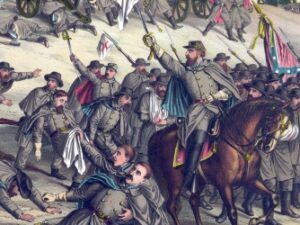 with and could not be ignored. Hood’s army had taken a severe beating at Franklin, but it nevertheless presented a threat by its mere presence and ability to maneuver. Therefore, Thomas knew he had to attack. He prepared cautiously, because he knew that Hood was not a complete pushover, and therefore, a poorly executed plan of attack could have ended in disaster. Thomas was concerned about his cavalry corps, because they were commanded by the energetic young Brigadier General James H Wilson, but they were poorly armed and mounted, and he did not want to proceed to a decisive battle without effective protection of his flanks. This was particularly important, since Wilson would be facing the horsemen of the formidable Forrest. Still, refitting the Union cavalry took time, so he had to be patient.
with and could not be ignored. Hood’s army had taken a severe beating at Franklin, but it nevertheless presented a threat by its mere presence and ability to maneuver. Therefore, Thomas knew he had to attack. He prepared cautiously, because he knew that Hood was not a complete pushover, and therefore, a poorly executed plan of attack could have ended in disaster. Thomas was concerned about his cavalry corps, because they were commanded by the energetic young Brigadier General James H Wilson, but they were poorly armed and mounted, and he did not want to proceed to a decisive battle without effective protection of his flanks. This was particularly important, since Wilson would be facing the horsemen of the formidable Forrest. Still, refitting the Union cavalry took time, so he had to be patient.
While Thomas knew what he was doing, Washington was not so patient, and in fact, they were fuming at the seeming procrastination. It was then that Sherman proposed his March to the Sea. Ulysses S Grant and Henry Halleck objected to it, because they thought that Hood would use the opportunity to invade Tennessee. In response, Sherman airily indicated that this was exactly what he wanted and that if Hood “continues to march North, all the way to Ohio, I will supply him with rations.” It sounded like a perfect plan, however, when the ever-confident Sherman disappeared into the heart of Georgia, Grant once again became concerned about an invasion of Kentucky or Ohio. Grant later said of the situation, “If I had been Hood, I would have gone to Louisville and on north until I came to Chicago.” His concern doubtless reflected Abraham Lincoln’s concern. Lincoln had little patience for slow generals and remarked of the situation, “This seems like the McClellan and Rosecrans strategy of do nothing and let the rebels raid the country.” Still, the plan to attack Nashville seems to have been the right move.
Washington continued to pressure Hood to push forward. Then on December 8, a bitter ice storm struck Nashville, stalling the plan again. While unusual for 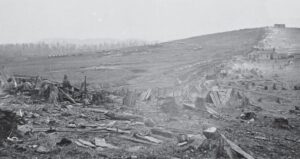 Nashville, the sub-freezing weather continued through December 12. Hood explained that to Grant, but when Thomas had still not moved by December 13, Grant directed that Major General John A Logan proceed to Nashville and assume command if Thomas had not yet initiated operations, by the time Logan arrived. Logan made it as far as Louisville by December 15, but on that day the Battle of Nashville had finally begun. A still impatient Grant left Petersburg on December 14, to take personal command. Apparently, he didn’t trust Logan much either. Once the battle began, Grant returned to Washington…a good thing, since three commanding officers might have been a bit awkward.
Nashville, the sub-freezing weather continued through December 12. Hood explained that to Grant, but when Thomas had still not moved by December 13, Grant directed that Major General John A Logan proceed to Nashville and assume command if Thomas had not yet initiated operations, by the time Logan arrived. Logan made it as far as Louisville by December 15, but on that day the Battle of Nashville had finally begun. A still impatient Grant left Petersburg on December 14, to take personal command. Apparently, he didn’t trust Logan much either. Once the battle began, Grant returned to Washington…a good thing, since three commanding officers might have been a bit awkward.
 When people are camping, the first rule is to make sure trash and leftover food are stored in airtight containers and that trash is disposed of far away from the campsite. The problem with food and trash left out in a campground is that the wild animals like the smell of these things, and they tend to come into camp at night when everyone is asleep. Before long the food they first found is gone, and they are looking for the next big score. Of course, not every animal is really dangerous when they get around food or trash, but many are. It is necessary to be careful around wild animals.
When people are camping, the first rule is to make sure trash and leftover food are stored in airtight containers and that trash is disposed of far away from the campsite. The problem with food and trash left out in a campground is that the wild animals like the smell of these things, and they tend to come into camp at night when everyone is asleep. Before long the food they first found is gone, and they are looking for the next big score. Of course, not every animal is really dangerous when they get around food or trash, but many are. It is necessary to be careful around wild animals.
By the same token, it isn’t unusual for campers to have their favorite beverage in the camp…often beer. And yes, humans tend to sometimes overdo their drinking and end up making fools of themselves because they are intoxicated. Sometimes they even get themselves into heated situations…ie arguments. Some people have even been kicked out of campgrounds for their intoxicated behavior, but we aren’t the only species that has a taste for alcohol. Believe it or not, animals like to indulge too, it they can get a hold of it.
One family found this out the hard way, in Port Hedland, Western Australia. It was the middle of the night, when a commotion was heard outside of a tent in the middle of the night. The campers turned on their torches and found a feral pig tearing open their supply of beer. By the time the pig finished the beer and headed off to look for food, it had consumed 18 cans of beer. Beer pretty much having the same kind of effect on the pig as it can on humans, the pig began to feel like he was invincible, so he decided to take on with a cow that was minding its own business nearby. Unfortunately, the pig came off on the losing end of the battle, when another 
 group of campers nearby, saw that the pig was being chased around their vehicle by a cow” Following the pig’s “ordeal,” the sheer amount of alcohol finally took its toll, and the pig passed out underneath a tree. Later, it was said that the police were reportedly trying to track down the pig. Apparently, the pig managed to elude the police and make its way home. What were the police planning to “charge” the pig with anyway…RUI (Running Under the Influence)??
group of campers nearby, saw that the pig was being chased around their vehicle by a cow” Following the pig’s “ordeal,” the sheer amount of alcohol finally took its toll, and the pig passed out underneath a tree. Later, it was said that the police were reportedly trying to track down the pig. Apparently, the pig managed to elude the police and make its way home. What were the police planning to “charge” the pig with anyway…RUI (Running Under the Influence)??

